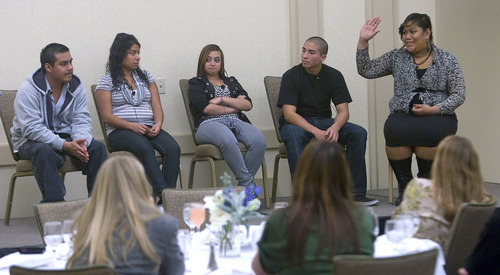This is an archived article that was published on sltrib.com in 2011, and information in the article may be outdated. It is provided only for personal research purposes and may not be reprinted.
Linda Toli didn't think she would finish high school.
She had missed too many days, fallen too far behind and thought the whole situation hopeless.
"I didn't think I belonged there because I was way behind and couldn't get help," said the 17 year old.
Toli — who has since gotten back on track after transferring to Horizonte Instruction and Training Center — was one of five students who shared their stories with education, state and community leaders Monday as part of an event called Dropout Prevention: Next Steps for Utah. Education leaders staged the event in the hope it will mark the beginning of a new approach to addressing the problem of high school dropouts in Utah.
Among last year's Class of 2010, 10 percent of students overall dropped out of school. Among Latino students — Utah's largest minority group — 26 percent dropped out.
Monday's event — which featured speakers, research and discussions — represented the launch of a partnership between the State Office of Education, the National Dropout Prevention Center and REL West, a program of WestEd, a nonprofit research, development and service agency.
Starting this year, the National Dropout Prevention Center will provide technical assistance to help five Utah schools — Alta High in Sandy, Highland High in Salt Lake City, Grantsville High in Grantsville, East Shore High School in Orem, and South Hills Middle School in Riverton — develop dropout prevention plans. In devising those plans, schools will look at research, causes, needs and strategies that have been proven effective. They're the first of about 30 schools in the state that leaders hope to help over the next few years.
The State Office also recently formed astatewide dropout advisory committee that will look at ways to better prevent dropouts in Utah, said Dawn Stevenson, a dropout prevention coordinator at the office.
State school board member Dixie Allen acknowledged it can be challenging to address the dropout problem given the financial strain faced by many schools, but she called it "absolutely necessary."
Russell Rumberger, a vice provost at the University of California and author of Dropping Out: Why Students Drop Out of High School and What Can Be Done About It,gave the keynote address Monday, outlining six recommendations culled from dozens of research studies and other materials by a U.S. Department of Education-sponsored expert panel. Those recommendations, which Stevenson said the state committee will likely look at in coming months, include: using data systems to identify students at risk of dropping out; assigning adult advocates to at-risk students; giving students academic support and enrichment; implementing programs to improve students' classroom behavior and social skills; personalizing learning environments and instruction; and providing rigorous and relevant instruction to better engage students and help prepare them for life after graduation.
Rumberger said there's no one way to fix the problem, just as there's no one reason students drop out of school.
"We know that dropping out is a complicated process that typically involves many different things that are going on, so effective programs do a lot of things to help engage kids and keep them in school," Rumberger said.
The students who spoke Monday confirmed as much. Most talked about the trouble they had in their traditional high schools and then spoke about how transferring to Horizonte has helped them.
Some of the students, including Toli, said attendance issues led to their problems. Others said school seemed pointless and still others said they felt discouraged because of academic difficulties.
A recent State Office of Education survey found attendance problems or life events such as pregnancy, incarceration, health or family issues are the most common reasons Utah dropouts say they leave school.
Several of the students who spoke Monday said part of the reason they struggled was because they didn't feel anyone was pushing them to succeed. Several said they didn't feel they had enough time with counselors or teachers. Utah had the highest student-to-teacher ratio in the nation — 27 students per teacher — in 2008-09, according to the National Center of Education Statistics. The state also had one of the highest counselor-to-student ratios in the nation in 2008-09, according to the American School Counselor Association.
"They don't have someone to push them, so they don't see the point," said Horizonte senior Nayeli Contreras, of why she thinks students drop out of school. "They'd rather be doing something else. They don't see the importance of it until later."
The students said attending the alternative high school has given them the chance to spend more time with teachers and advisors who help guide them toward strengths and interests. Toli, for example, said she's discovered a love of math.
Now, she says she can't wait for college.
"When I was in my old school, I never thought of going to college because I never thought I would graduate, and now that I'm at Horizonte I hope," Toli, said, pausing to correct herself, "no —I will graduate."
Twitter: @lschencker









